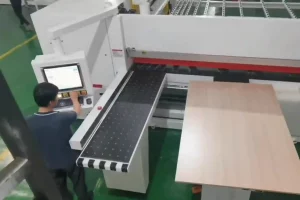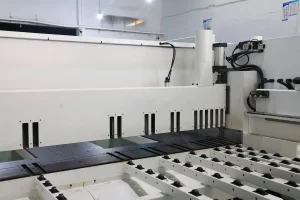
Understanding Beam Saw Safety Measures: A Comprehensive Guide
Woodworking beam saws are indispensable tools in carpentry and construction, known for their efficiency in making precise cuts. However, their utility comes with inherent risks that require careful handling and adherence to safety protocols. This guide explores essential safety measures to ensure both user safety and optimal performance when operating woodworking beam saws.
Introduction to Woodworking Beam Saws
Woodworking beam saws play a crucial role in various woodworking tasks, from cutting large panels to precise sizing of lumber. The primary component of these saws is the high-speed rotating blade, which poses significant risks if not handled properly. The blade’s sharp teeth can cause severe injuries, making it imperative for users to prioritize safety at all times.
Safety Precautions: Before diving into operation, it’s essential to conduct a thorough inspection of the beam saw. Ensure that the blade is securely fastened and that the saw’s baseplate is stable. Any signs of damage or wear on the blade should prompt immediate replacement to prevent operational hazards. Additionally, wearing appropriate personal protective equipment (PPE), such as safety goggles, gloves, and a face mask, is non-negotiable to shield against debris, dust, and potential blade contact.
Conclusion: In essence, understanding the foundational safety measures of woodworking beam saws sets the stage for safe and effective operation. By familiarizing oneself with these precautions and diligently implementing them, woodworkers can mitigate risks and enhance their operational efficiency.
Maintaining Safety During Beam Saw Operation
Operating a woodworking beam saw demands a methodical approach to ensure both safety and precision in cuts. The operational phase introduces critical safety considerations that, when overlooked, can lead to accidents and injuries. Here’s a comprehensive look at how to maintain safety during beam saw operation.
Safety Procedures: When making cuts with a beam saw, secure the workpiece firmly and ensure a stable support surface to prevent movement. Approach the cutting process with caution, maintaining a safe distance from the blade’s path to avoid accidental contact. It’s crucial to keep fingers and hands away from the blade’s teeth throughout the operation. Additionally, never attempt to adjust the saw or the workpiece while the blade is in motion, as this significantly heightens the risk of injury.
Conclusion: Safety during beam saw operation hinges on meticulous adherence to procedural guidelines and constant vigilance. By adhering to these protocols, woodworkers can ensure a safe working environment and achieve precise cutting results without compromising on safety.
Transporting and Storing Woodworking Beam Saws Safely
The safety considerations for woodworking beam saws extend beyond operation to include proper handling during transport and storage. Neglecting safety protocols during these phases can result in unforeseen accidents and damage to the equipment. Understanding how to safely transport and store beam saws is essential for maintaining their longevity and ensuring continued safe usage.
Safety Tips: When transporting a beam saw, always ensure that the blade is fully retracted into the saw body and securely fastened to prevent any accidental exposure. Use designated carrying handles to maintain control and avoid placing unnecessary strain on the equipment. During storage, store the saw in a secure location that is inaccessible to children or unauthorized personnel. It’s also advisable to cover the blade with a protective sheath or guard to prevent accidental contact and minimize the risk of damage.
Conclusion: Proper handling during transportation and storage of woodworking beam saws is integral to preserving their functionality and ensuring ongoing safety. By adhering to these guidelines, woodworkers can prolong the lifespan of their equipment and minimize the risk of accidents in the workshop environment.
Best Practices for Enhancing Beam Saw Safety
Achieving optimal safety with woodworking beam saws involves more than just following basic guidelines—it requires integrating best practices into everyday operations. These practices encompass proactive measures aimed at reducing risks and enhancing overall safety and efficiency in woodworking tasks.
Safety Strategies: One of the fundamental practices is to maintain a flat orientation of the beam saw blade against the workpiece to minimize the occurrence of kickbacks. Avoiding aggressive cuts and ensuring the blade is suitable for the task at hand are crucial steps in preventing blade deflection or breakage. Additionally, when working in confined spaces, consider using smaller blades or alternative cutting tools that offer greater maneuverability and control.
Conclusion: By adopting and consistently implementing best practices, woodworkers can elevate beam saw safety to new heights. These strategies not only mitigate risks associated with operation but also contribute to improved productivity and precision in woodworking projects.
This comprehensive guide has delved into the crucial aspects of woodworking beam saw safety, emphasizing the importance of meticulous handling and adherence to safety measures. From understanding the inherent risks associated with beam saws to implementing best practices for safe operation, each section has provided invaluable insights aimed at fostering a secure working environment.
FAQ
Q: What are woodworking beam saws? A: Woodworking beam saws are powerful tools used in carpentry and construction for cutting large panels and lumber with precision.
Q: Why is safety important when using woodworking beam saws? A: Safety is paramount when operating beam saws due to the high-speed rotating blade, which can cause severe injuries if not handled properly.
Q: What personal protective equipment (PPE) should I wear when using a woodworking beam saw? A: It is essential to wear safety goggles, gloves, and a face mask to protect against debris, dust, and potential blade contact.
Q: How should woodworking beam saws be transported and stored safely? A: When transporting, ensure the blade is retracted and securely fastened. Store the saw in a secure location, away from children and unauthorized personnel, and consider using a blade guard for added protection.
Q: What are some best practices for enhancing beam saw safety? A: Best practices include maintaining a flat blade orientation during cuts, avoiding aggressive cutting techniques, and using appropriate blades for different tasks.
This FAQ section addresses common queries about woodworking beam saws, consolidating essential information from the guide to promote safe and effective usage in woodworking environments.






































